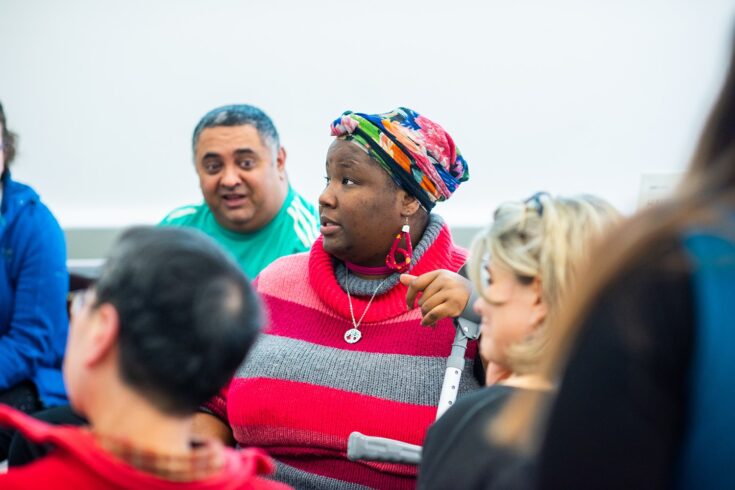This month, we’ve published a report that we commissioned from Vocal, called, ‘Looking forward: working with the Medical Research Council (MRC) towards a public involvement strategy’.
Like many clinical researchers, I have found that working closely with patients has brought real benefits to my research. However, this new report focuses on involving the public in non-clinical and laboratory-based research, something that is often considered much harder to do well.
For those of us who worked on this project with Vocal, we were taken on a journey. From seeing public involvement in non-clinical research as a challenge, to recognising the many opportunities to weave public involvement throughout the research we support to maximise its relevance and impact.
Adding value to non-clinical and lab science
Involving the public adds value to laboratory research by motivating researchers. It helps them to focus on areas that will benefit patients, making sure that public-funded research is accountable, and showing the fundamental importance of basic discovery and laboratory science.
As one MRC-funded principal investigator highlighted in Vocal’s report:
Patient and public involvement has really energised our researchers, seriously energised and motivated them and got them to think about what they were doing in a different way. And just made them feel more involved and more useful.
Unlike clinical researchers, scientists carrying out non-clinical research may not have direct contact with patients. Or they might be researching healthy human physiology rather than disease. So, it is not always easy for researchers to see how to involve the public, or who to involve.
Exploring best practice in public involvement
Vocal worked collaboratively with an external advisory group of people with expertise in patient advocacy, public involvement and engagement. They surveyed and spoke with people across different communities to find out about the innovative public involvement activities they’re already doing. This included:
- staff in MRC’s units, centres and institutes
- public partners
- public engagement and communication professionals
- individual researchers
Many scientists described doing a wide range of public engagement activities, such as blogs and educational outreach. But far fewer were actively partnering with the public or patients to co-produce research.
However, Vocal identified some exciting and successful partnerships between researchers and the public that demonstrate the extraordinary potential for extending public involvement to non-clinical research.
Examples such as the patient-led Oxford Blood Group’s work with the MRC Human Immunology Unit which has involved and motivated all members of the research team. Or the partnership between UK Research and Innovation (UKRI) and the McPin Foundation to set up a Young Person’s Advisory Group. This group helped shape the Adolescence, Mental Health and the Developing Mind funding initiative.
As a public partner explained:
We were involved at every single stage and we felt like our opinions were heard. We were even able to be a part of the interviews and we were asking the questions. In the discussions afterwards they actually considered our opinions when deciding which proposals to take through, so I felt like we were really heard.
A new approach to research culture
The report concludes that:
Now is the time for a new framing of MRC’s conception of, and ambitions for public involvement as part of an open, transparent, trustworthy and thriving research environment working to the highest standards of research quality and inclusion.
To successfully move public involvement into a non-clinical research environment, a new approach is needed. It is important that we focus on changing research culture to become more inclusive rather than simply adding public involvement to each individual research project.
As one public involvement practitioner said:
I’m genuinely not sure if we can co-produce for example tissue culture experiments. But we can co-create the research environment in which such studies are born, then they will reflect the active involvement of patients and communities.
Tailored partnerships and recognition
The report emphasises the fundamental importance of focusing public involvement activities where they are most meaningful, and tailoring partnerships to each specific research context. This means that it is sometimes best to work with people who have a particular health condition. While at other times it is more important to involve individuals who can share their broader life experience to enrich research.
A key goal for MRC must be to enhance our support and recognition for good public involvement practice within research teams. As one MRC-funded researcher said:
Recognition is really important, and this needs to be equal to the recognition demonstrated for research.
Learning from Vocal’s insights and recommendations
As we publish Vocal’s report, we are looking forward with excitement to putting their insights and recommendations into practice. In the coming year, we will co-develop an MRC strategy for public involvement and engagement which aligns with the UKRI public engagement strategy. We hope this stimulates changes to research culture that will allow public involvement across both clinical and non-clinical research to grow and flourish.
Further information
If you want to read more about Vocal’s findings, these are described in their full report and a shorter executive summary. The evidence that Vocal collected from published papers, a national survey, interviews and workshops can be found in the appendices to the report.
Read updates on MRC activities related to public involvement and engagement.
Vocal is based in Greater Manchester and works locally, nationally, internationally to make a real difference to the future of health and research. It’s a not-for-profit organisation, hosted by Manchester University NHS Foundation Trust in partnership with The University of Manchester.




